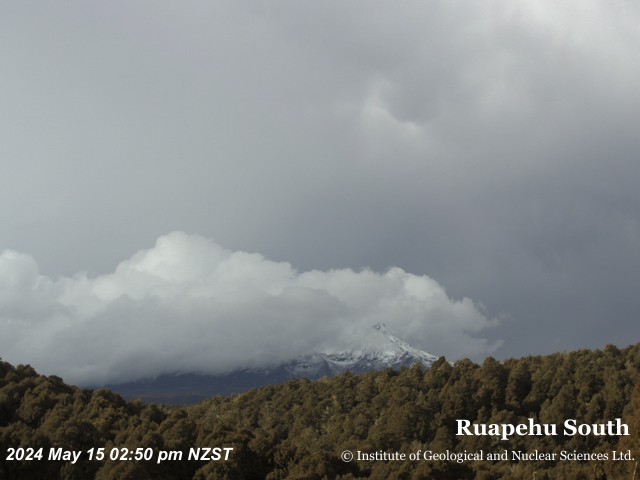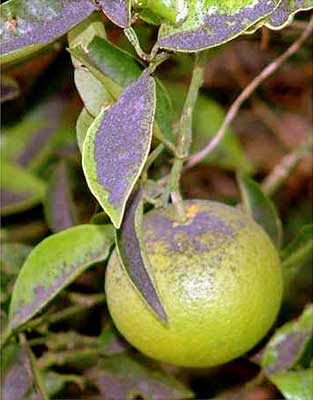Ruapehu is one of the world's most active volcanoes and the largest active volcano in New Zealand. It is the highest point in the North Island and includes three major peaks: Tahurangi (2,797 m), TeHeuheu (2,755 m) and Paretetaitonga (2,751 m). The deep, active crater is between the peaks and fills with a crater lake between major eruptions.At about 8:20pm on 25 September 2007 a hydrothermal eruption occurred without warning. The eruption was accompanied by a 7 minute long earthquake, 2.9 on the Richter Scale. The ash from the volcano affected the farmland, crops and livestock because it contained flourine. Even a small layer of ash on the grass can be toxic to sheep and cattle that eat it.
.
Volcano effects
on crops
livestock, sheep, cows
VolcanoExperience.com
Ash and its effects
MOUNT RUAPEHU,NEW ZEALAND VOLCANO WEB CAM
The land around volcanoes, which are active or dormant, is often used for farmland and grazing animals. Ash from erupting volcanoes could make grass toxic to the cows or sheep that graze there. It can also kill plants and crops.
However, on some farmlands. ash that is in soil on these farms gives their crops their individual flavors. Grapes are grown near Mount Vesuvius in Italy, citrus fruit near Moutn Etna in Italy, and coffee is grown in Costa Rica.
Could the plume/ash from Eyafjallajoekull effect European food supplies?
Report - April 2010 after it erupted
European Food Safety Authority (EFSA)
Statement on the possible risks for public and animal health from the contamination of the feed and food chain due to possible ash-fall following the eruption of the Eyjafjallajökull volcano in Iceland - urgent advice
EFSA report.pdf
The ash from erupting volcanoes can damage crops and livestock
The USGS (United States Geological Suvey) says severity depends on:
• ash thickness
• the type and growing condition of a crop,
• the presence of soluble fluoride on the
ash
• timing and intensity of subsequent
rainfall,
• condition of pasture and animals prior to
ash fall
• availability of uncontaminated feed and
water.





Knowledge, Fun, Experience, VolcanoExperience.com



Ash from volcanoes in different parts of the world contain different chemical elements. Flourine is the most toxic to plants and animals and is in many volcano eruptions. It attaches to the ash and travels with the wind to the farmlands around the volcano. New Zealand, Italian, and Iceland's volcanoes have been studied to understand the damage that can be caused by flourine. It is known that if livestock eat the grass covered with ash, they get gastrointestinal blockages and die. As little as a thin layer of 1 mm of ash on grass can kill grazing sheep or cows. If there are no other sources of feed for the anim,als they could also die of starvation. Deers and other wildlife living in forests also die if their food supply is covered with ash. Plants themselves can be damaged by the ash, depending on the amount that falls. Crops are often lost because the cost of washing the ash or uncontaminating the crop is too high. The water supply near the farmland is also contaminated. Farm equipment might be damaged by the rough qualities in ash particles. Water pumping equipment can be harmed if not enclosed or covered with tarps.
Volcanoes can erupt in one explosive event or in a series of smaller eruptions that could last for months or years. Sheep grazing on pasture land near the Mount Ruapehu, New Zealand died from the eruption in OCtober 1995. On local dairy farms the cows produced less milk, and the beef was not safe to eat. Wool from the sheep was also not good. Flourine is extremely toxic and is on the grass and in the soil until rain washes the ash ways or reacts with the flourine removing it from the ash. Rain can also wash thin coats of ash on plants off and into the soil. Some crops get their flavor from the ash-soil they are grown in. Coffee in parts of Costa Rica, grapes in Italy or citrus fruit in Italy are examples of crops that grow in soil where volcanoes have erupted.
Thick ashfalls of more than 10-15 cm (4-6 inches) buries the pastures and soil. This kills anything living there because it deprives the microbes in the soil and the grasses and crops of oxygen. The pasture has to be re-established before sheep could graze there again.
Plants and crops can survive if the ash fall is less than 5 cm (2 inches)
It takes about a year for the ash to be worked into the soil. Ash also kills insects good and bad. It traps water and could act as mulch.
Rain is a major factor in cleaning the ash fall. The sooner it rains after an eruption the cleaner some areas might be. If crops or grazing lands are on the slope of the volcano, rain can wash the ash down the mountain. However, land where the rain flows to could get increased contamination. Wet ash compacts the ash to 1/3 of its original thickness. Wind can also move ash into ash drifts.
Depending on the volcanoes location, the ash could aslo contain sulfur and other chemical elements and minerals. Sulfur or silica are aslo studied. Soil mixed with ash can have elevated sulfur levels and lowers the pH. This reduces the amount of phosphated and other minerals in the soil making it difficult for plants to grow. Rain mixed with ash and volcano gases after an eruption would be acidic and could kill the pasture land and crops. Acid rain damaged the leaves of coffee plants in Costa Rica.
USGS-Volcanic Ash: Effects & Mitigation Strategies
http://volcanoes.usgs.gov/ash/agric
Could the plume/ash from Eyafjallajoekull affect European food supplies?
Report - April 2010 after it erupted
European Food Safety Authority (EFSA)
Statement on the possible risks for public and animal health from the contamination of the feed and food chain due to possible ash-fall following the eruption of the Eyjafjallajökull volcano in Iceland - urgent advice
pdf
EFSA report.pdf
Chlorosis Produced by Fluorine on Citrus in Florida
[Science 25 May 1956: Vol. 123. no. 3204, pp. 933 - 934]
I. W. WANDER and J. J. MCBRIDE, JR.
http://www.sciencemag.org/cgi/pdf_extract/123/3204/933
pdf
http://www.sciencemag.org/cgi/reprint/123/3204/933.pdf
Human fluorosis related to volcanic activity: a review
http://www2.fluoridealert.org/Pollution/Volcanoes/Human-fluorosis-related-to-volcanic-activity-a-review
pdf
Human fluorosis related to volcanic activity: a review
Walter D’Alessandro
Istituto Nazionale di Geofisica e Vulcanologia – Sezione di Palermo, via
La Malfa, 153, 90146 Palermo, Italy
Response of Soil Inorganic Nitrogen to Land Use and Topographic Position in the Cofre de Perote Volcano (Mexico). [Environ Manage. 2010 Jun 26. [Epub ahead of print]
Campos C A.
Instituto de Ecología, A. C., Apartado Postal 63, CP 91000, Veracruz, Xalapa, Mexico,
This study addressed the effects of land use and slope position on soil inorganic nitrogen and was conducted in small watersheds. The study covered three land use types: tropical cloud forest, grassland, and coffee crop. To conduct this research, typical slope small watersheds were chosen in each land use type. Slopes were divided into three positions: shoulder, backslope, and footslope. At the center of each slope position, soil sampling was carried out. Soil inorganic nitrogen was measured monthly during a period of 14 months (July 2005-August 2006) with 11 observations. Significant differences in soil NH(4) (+)-N and NO(3) (-)-N content were detected for both land use and sampling date effects, as well as for interactions. A significant slope position-by-sampling date interaction was found only in coffee crop for NO(3) (-)-N content. In tropical cloud forest and grassland, high soil NH(4) (+)-N and low NO(3) (-)-N content were recorded, while soil NO(3) (-)-N content was high in coffee crop. Low NO(3) (-)-N contents could mean a substantial microbial assimilation of NO(3) (-)-N, constituting an important mechanism for nitrogen retention. Across the entire land use set, the relationship between soil temperature and soil inorganic N concentration was described by an exponential decay function (N = 33 + 2459exp(-0.23T), R (2) = 0.44, P < 0.0001). This study also showed that together, soil temperature and gravimetric soil water content explained more variation in soil inorganic N concentration than gravimetric soil water content alone.
The use of tree-rings and foliage as an archive of volcanogenic cation deposition.
[Environ Pollut. 2007 Jul;148(1):48-61. Epub 2007 Jan 17.]
Watt SF, Pyle DM, Mather TA, Day JA, Aiuppa A.
Department of Earth Sciences, University of Cambridge, Downing Street, Cambridge, UK.
Tree cores (Pinus nigra ssp. laricio) and leaves (Castanea sativa) from the flanks of Mount Etna, Sicily were analysed by ICP-MS to investigate whether volcanogenic cations within plant material provide an archive of a volcano's temporal and spatial depositional influence. There is significant compositional variability both within and between trees, but no systematic dendrochemical correlation with periods of effusive, explosive or increased degassing activity. Dendrochemistry does not provide a record of persistent but fluctuating volcanic activity. Foliar levels of bioaccumulated cations correspond to modelled plume transport patterns, and map short-term volcanic fumigation. Around the flanks of the volcano foliar variation is greater for volatile cations (Cs, Cd, Pb) than for lithophilic cations (Ba, Sr), consistent with trace-metal supply from volcanic aerosol during quiescent periods.
Observational evidence for volcanic impact on sea level and the global water cycle.
[Proc Natl Acad Sci U S A. 2007 Dec 11;104(50):19730-4. Epub 2007 Dec 3.]
Grinsted A, Moore JC, Jevrejeva S.
Arctic Centre, University of Lapland, PL122, 96101 Rovaniemi, Finland.
It has previously been noted that there are drops in global sea level (GSL) after some major volcanic eruptions. However, observational evidence has not been convincing because there is substantial variability in the global sea level record over periods similar to those at which we expect volcanoes to have an impact. To quantify the impact of volcanic eruptions we average monthly GSL data from 830 tide gauge records around five major volcanic eruptions. Surprisingly, we find that the initial response to a volcanic eruption is a significant rise in sea level of 9 +/- 3 mm in the first year after the eruption. This rise is followed by a drop of 7 +/- 3 mm in the period 2-3 years after the eruption relative to preeruption sea level. These results are statistically robust and no particular volcanic eruption or ocean region dominates the signature we find. Neither the drop nor especially the rise in GSL can be explained by models of lower oceanic heat content. We suggest that the mechanism is a transient disturbance of the water cycle with a delayed response of land river runoff relative to ocean evaporation and global precipitation that affects global sea level. The volcanic impact on the water cycle and sea levels is comparable in magnitude to that of a large El Niño-La Niña cycle, amounting to approximately 5% of global land precipitation.
© 2010 by volcanoexpierence.com · All Rights reserved · E-Mail: admin@volcanoexperience.com
Volcano effects on crops
livestock, sheep, cows
VOLCANO FACTS
ICELAND - Eyjafjallajokull
airplanes in Europe
gas plumes travels
It is located on the southern part of Iceland. It has erupted twice throughout this year and has caused many air traffic problems.
. Read more ...
Hawaii - Kilauea
indoor air quality,
breathing silica ash particles
bronchitis, emphysema, asthma
Kilauea is located on the southeast part of Hawaii Island, Hawaii. In the Hawaii religion they believe that the goddess of volcanoes, Pele, lives on this volcano.. Read more ...
COSTA RICA - Arenal, Geotourism
On almost a daily basis, red-hot rocks crash down its steep slopes and volcanic grumbles produce huge ash columns above the crater. Read more ...
New Zealand - Ruapehu
crops, livestock, vegetation
It is the highest point in the North Island and includes three major peaks: Tahurangi (2,797 m), TeHeuheu (2,755 m) and Paretetaitonga (2,751 m). . Read more ...
ITALY - Mount Etna
Volcano Mercury - Soil, Water
It is the largest active volcano in Europe, currently standing 3,329 metres (10,922 ft) high, though this varies with summit eruptions; the mountain is 21 m (69 ft) lower now than it was in 1981. Read more ...
Guatemala - Pacaya
Lava, Boulders,
buildings, transportation, communication, power outages
After being dormant for a century, it erupted violently in 1965 and has been erupting continuously since then.
Read more ...
Italy - Mount Vesuvius
Ancient Volcanoes
Mount Vesuvius is best known for its eruption in AD 79 that led to the destruction of the Roman cities of Pompeii and Herculaneum.
Read more...
Indonesia - Krakatoa
Krakatoa, also known as Krakatow, is another still-dangerous volcanic island, located in Indonesia in the Sunda Strait.
Read more...
Underwater Hydrothermal Volcanoes
Bacteria from Volcanoes
Bacteria that live near underwater can metabolize Iron, Sulfur and Methane.
Read more...
Mars
Olympus Mons is the largest volcano on Mars. Scientists study volcanoes on earth to compare to volcanoes on Mars.
Read more...




























